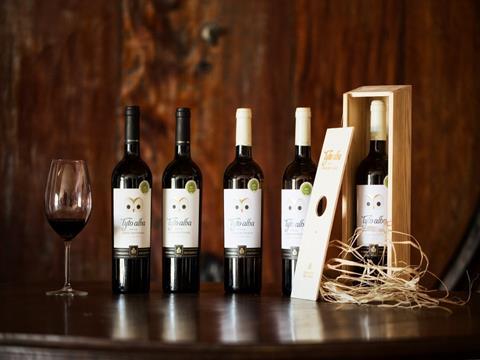
Companhia das Lezírias’s Tyto Alba Wine packaging includes the lightweight bottle with a fibre-based label and capsule, housed inside a pinewood box that can be made into a nesting box for birds – a unique second life that complements the signature owl branding of the portfolio.
We spoke to David Ferreira, winemaker at Companhia das Lezírias, to find out more about Tyto Alba Wine’s distinctive bottle and box.
A sustainable twist on bottle basics
Based in Portugal, Companhia das Lezírias oversees a vineyard of around 130 hectares, where a non-interventional technique is used to cultivate grapes for the company’s extensive portfolio of wines.
But wine is not the only end product of the vineyard. According to Ferreira, the Tyto Alba wine bottles feature “a recycled paper label, made of 15% vineyard-sourced fibres”. The capsule that tops the bottle is, Ferreira says, “a PLC polymer made of starch, which is totally compostable”, while the stopper is apparently 100% natural cork. This helps to increase the overall recyclability of the wine bottle by considering the end-of-life of its constituent parts, which can sometimes get placed directly into waste streams or, when still attached to the bottle, interfere with recycling processes.
The wine bottle itself is made to be lightweight, coming in at 380g. Based on other standards and innovations in the industry, ‘eco’ bottles usually weigh between 300 and 450g, which places the Tyto Alba range in this category. A lighter bottle can translate to better transport efficiencies, as well as a lower carbon footprint; Ferreira estimates that the company’s bottle is “one of the lightest […] on the market” and reduces the product’s carbon emissions by 30%.
The bottle design demonstrates a sense of the packaging reflecting the processes and imperatives behind the wine. As Ferreira highlights, the Tyto Alba packaging features details about Companhia das Lezírias’s operations with the intention of “linking the consumer to our way of thinking”. The packaging itself, therefore, becomes part of the appeal of the product for consumers who prioritise sustainability.
From wine box to bird box
The stand-out feature of the Tyto Alba range is its box. “The box is designed for protecting our dear bottles, but also, in its 2nd life, it can be reused as a nest for birds,” explains Ferreira.
Made from pine wood, the box features a sloped roof and “a small round opening right in front of the picture of our Tyto Alba Owl on the label” – this gives the impression of the barn owl logo peering out of the box when packaged together on the shelves. Consolidating a strong sense of brand identity and recognition, this brings the packaging’s design to life in 3D, with a tactile and interactive appearance before it is even opened.
The Tyto Alba packaging does not reach the end of its usefulness after the wine is taken out and consumed. The box is designed to be repurposed as a bird box with, Ferreira notes, “a small manual and a portion of natural fibre-based rope” included with the packaging “so you can install your nest on your favourite tree.”
As such, the box becomes “a fun activity that can be done with family” and “an opportunity for the local biodiversity to find a refuge”, according to Ferreira.
For consumers, the Tyto Alba box is the basis of a shared experience that could help to educate and foster an interest in the protection of wild birds. The active engagement with the packaging has the potential to positively impact the consumer’s local environment, being suitable for “installation in urban and rural locations”. It also encourages consumers to remember and return to the product – perhaps purchasing or recommending it for a friend based on the uniqueness of the box.
Meanwhile, the emphasis on biodiversity is part of Companhia das Lezírias’s core values in terms of land management and business operations, and the second life of the box helps to pay this forward into the behaviour of its consumers as well. Ferreira adds: “This box replicates the ones we use in our forest management to enhance the biodiversity of the woodlands.”
Like the bottle, the box intentionally reflects the company’s values, and, in Ferreira’s words, “way[s] of doing”. This reinforces the consumer’s trust in Companhia das Lezírias’s sustainability objectives and helps to demystify how these goals may be achieved going forward – again, drawing the “eco-conscious consumer”, a key demographic identified by Ferreira, back to the brand in the future.
What’s next?
“Right now, we are thinking of using the bag in box solution for our higher range of wines, such as the Tyto Alba,” Ferreira says. “This is a way of getting away from the glass bottle.”
While special blends by Companhia das Lezírias are likely to still be packed in a traditional bottle to allow the wine to age for longer, Ferreira notes of the bag in box solution that “more and more volumes of wine from all price ranges will be packed this way in the future”. Like other brands shifting towards similar solutions, bag in box offers benefits including transport and storage savings, extended shelf life, and a potentially reduced carbon footprint.
Ultimately, with sustainability as the focus, Companhia das Lezírias intends to expand its core winery operations into “bigger and more friendly containers that are more sustainable to ship to the consumer”. The novel design of the Tyto Alba box has potential environmental benefits through its reuse, but the company appears to acknowledge the importance of a diverse and holistic approach to meeting sustainability initiatives.








![_DSC5322[13]](https://d2wrwj382xgrci.cloudfront.net/Pictures/100x67/4/4/7/9447__dsc532213_109933.jpg)

